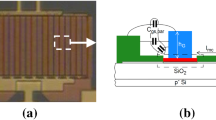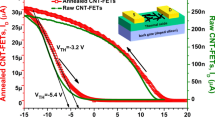Abstract
The speed of frequency response of all published carbon nanotube (CNT) integrated circuits (ICs) is far from that predicted. The transient response of CNT ICs is explored systematically through the combination of experimental and simulation methods. Complementary field-effect-transistor (FET) based inverters were fabricated on a single semiconducting CNT, and the dynamic response measurement indicates that it can only work at an unexpectedly low speed, i.e. with a large propagation delay of 30 μs. Owing to the larger output resistance of CNT FETs, the existence of parasitic capacitances should induce much larger resistive-capacitive (RC) delay than that in Si ICs. Through detailed analysis combining simulation and experimental measurements, several kinds of parasitic capacitances dragging down the actual speed of CNT FET ICs are identified one by one, and each of them limits the speed at different levels through RC delay. It is found that the parasitic capacitance from the measurement system is the dominant one, and the large RC delay lowers the speed of CNT FETs logic circuits to only several kHz which is similar to the experimental results. Various optimized schemes are suggested and demonstrated to minimize the effect of parasitic capacitances, and thus improve the speed of CNT ICs.

Similar content being viewed by others
References
Kienle, D.; Léonard, F. Terahertz response of carbon nanotube transistors. Phys. Rev. Lett. 2009, 103, 026601.
Chaste, J.; Lechner, L.; Morfin, P.; Fève, G.; Kontos, T.; Berroir, J. M.; Glattli, D. C.; Happy, H.; Hakonen, P.; Plaçais, B. Single carbon nanotube transistor at GHz frequency. Nano Lett. 2008, 8, 525–528.
Rutherglen, C.; Jain, D.; Burke, P. Nanotube electronics for radiofrequency applications. Nat. Nano 2009, 4, 811–819.
Che, Y. C.; Badmaev, A.; Jooyaie, A.; Wu, T.; Zhang, J. L.; Wang, C.; Galatsis, K.; Enaya, H. A.; Zhou, C. W. Self-aligned t-gate high-purity semiconducting carbon nanotube RF transistors operated in quasi-ballistic transport and quantum capacitance regime. ACS Nano 2012, 6, 6936–6943.
Burke, P. J. AC performance of nanoelectronics: Towards a ballistic THz nanotube transistor. Solid-State Electron. 2004, 48, 1981–1986.
Nougaret, L.; Happy, H.; Dambrine, G.; Derycke, V.; Bourgoin, J. P.; Green, A. A.; Hersam, M. C. 80 GHz fieldeffect transistors produced using high purity semiconducting single-walled carbon nanotubes. Appl. Phys. Lett. 2009, 94, 243505.
Anantram, M. P. Current-carrying capacity of carbon nanotubes. Phys. Rev. B 2000, 62, 4837–4840.
Avouris, P.; Chen, Z. H.; Perebeinos, V. Carbon-based electronics. Nat. Nano 2007, 2, 605–615.
Purewal, M.; Hong, B.; Ravi, A.; Chandra, B.; Hone, J.; Kim, P. Scaling of resistance and electron mean free path of single-walled carbon nanotubes. Phys. Rev. Lett. 2007, 98, 186808.
Ilani, S.; Donev, L. A. K.; Kindermann, M.; McEuen, P. L. Measurement of the quantum capacitance of interacting electrons in carbon nanotubes. Nat. Phys. 2006, 2, 687–691.
Pomorski, P.; Pastewka, L.; Roland, C.; Guo, H.; Wang, J. Capacitance, induced charges, and bound states of biased carbon nanotube systems. Phys. Rev. B 2004, 69, 115418.
Zhang, Z. Y.; Wang, S.; Ding, L.; Liang, X. L.; Pei, T.; Shen, J.; Xu, H. L.; Chen, Q.; Cui, R. L.; Li, Y. et al. Self-aligned ballistic n-type single-walled carbon nanotube field-effect transistors with adjustable threshold voltage. Nano Lett. 2008, 8, 3696–3701.
Javey, A.; Guo, J.; Farmer, D. B.; Wang, Q.; Wang, D. W.; Gordon, R. G.; Lundstrom, M.; Dai, H. J. Carbon nanotube field-effect transistors with integrated ohmic contacts and high-κ gate dielectrics. Nano Lett. 2004, 4, 447–450.
Franklin, A. D.; Chen, Z. H. Length scaling of carbon nanotube transistors. Nat. Nanotechnol. 2010, 5, 858–862.
Franklin, A. D.; Luisier, M.; Han, S. J.; Tulevski, G.; Breslin, C. M.; Gignac, L.; Lundstrom, M. S.; Haensch, W. Sub-10 nm carbon nanotube transistor. Nano Lett. 2012, 12, 758–762.
Chau, R.; Datta, S.; Doczy, M.; Doyle, B.; Jin, B.; Kavalieros, J.; Majumdar, A.; Metz, M.; Radosavljevic, M. Benchmarking nanotechnology for high-performance and low-power logic transistor applications. IEEE Trans. Nanotechnol. 2005, 4, 153–158.
Ding, L.; Zhang, Z. Y.; Liang, S. B.; Pei, T.; Wang, S.; Li, Y.; Zhou, W. W.; Liu, J.; Peng, L. M. CMOS-based carbon nanotube pass-transistor logic integrated circuits. Nat. Commun. 2012, 3, 677.
Sun, D. M.; Timmermans, M. Y.; Kaskela, A.; Nasibulin, A. G.; Kishimoto, S.; Mizutani, T.; Kauppinen, E. I.; Ohno, Y. Mouldable all-carbon integrated circuits. Nat. Commun. 2013, 4, 2302.
Sun, D. M.; Timmermans, M. Y.; Tian, Y.; Nasibulin, A. G.; Kauppinen, E. I.; Kishimoto, S.; Mizutani, T.; Ohno, Y. Flexible high-performance carbon nanotube integrated circuits. Nat. Nano 2011, 6, 156–161.
Ryu, K. M.; Badmaev, A.; Wang, C.; Lin, A.; Patil, N.; Gomez, L.; Kumar, A.; Mitra, S.; Wong, H. S. P.; Zhou, C. W. CMOS-analogous wafer-scale nanotube-on-insulator approach for submicrometer devices and integrated circuits using aligned nanotubes. Nano Lett. 2009, 1, 189–197.
Cao, Q.; Kim, H. S.; Pimparkar, N.; Kulkarni, J. P.; Wang, C. J.; Shim, M.; Roy, K.; Alam, M. A.; Rogers, J. A. Medium-scale carbon nanotube thin-film integrated circuits on flexible plastic substrates. Nature 2008, 454, 495–500.
Yu, W. J.; Kim, U. J.; Kang, B. R.; Lee, I. H.; Lee, E. H.; Lee, Y. H. Adaptive logic circuits with doping-free ambipolar carbon nanotube transistors. Nano Lett. 2009, 9, 1401–1405.
Shulaker, M. M.; Hills, G.; Patil, N.; Wei, H.; Chen, H. Y.; Wong, H. S. P.; Mitra, S. Carbon nanotube computer. Nature 2013, 501, 526–530.
Pei, T.; Zhang, P.; Zhang, Z. Y.; Qiu, C. G.; Liang, S. B.; Yang, Y. J.; Wang, S.; Peng, L. M. Modularized construction of general integrated circuits on individual carbon nanotubes. Nano Lett. 2014, 14, 3102–3109.
Bachtold, A.; Hadley, P.; Nakanishi, T.; Dekker, C. Logic circuits with carbon nanotube transistors. Science 2001, 294, 1317–1320.
Javey, A.; Kim, H.; Brink, M.; Wang, Q.; Ural, A.; Guo, J.; McIntyre, P.; McEuen, P.; Lundstrom, M.; Dai, H. J. High-κ dielectrics for advanced carbon-nanotube transistors and logic gates. Nat. Mater. 2002, 1, 241–246.
Javey, A.; Wang, Q.; Ural, A.; Li, Y. M.; Dai, H. J. Carbon nanotube transistor arrays for multistage complementary logic and ring oscillators. Nano Lett. 2002, 2, 929–932.
Zhang, Z. Y.; Liang, X. L.; Wang, S.; Yao, K.; Hu, Y. F.; Zhu, Y. Z.; Chen, Q.; Zhou, W. W.; Li, Y.; Yao, Y. G.; Zhang, J.; Peng, L. M. Doping-free fabrication of carbon nanotube based ballistic CMOS devices and circuits. Nano Lett. 2007, 7, 3603–3607.
Zhang, Z. Y.; Wang, S.; Wang, Z. X.; Ding, L.; Pei, T.; Hu, Z. D.; Liang, X. L.; Chen, Q.; Li, Y.; Peng, L. M. Almost perfectly symmetric SWCNT-based CMOS devices and scaling. ACS Nano 2009, 3, 3781–3787.
Yan, H.; Choe, H. S.; Nam, S.; Hu, Y. J.; Das, S.; Klemic, J. F.; Ellenbogen, J. C.; Lieber, C. M. Programmable nanowire circuits for nanoprocessors. Nature 2011, 470, 240–244.
Guo, J.; Hasan, S.; Javey, A.; Bosman, G. Assessment of high-frequency performance potential of carbon nanotube transistors. IEEE Trans. Nanotechnol. 2005, 4, 715–721.
Dwyer, C.; Cheung, M.; Sorin, D. J. Semi-empirical SPICE models for carbon nanotube FET logic. In The Proceedings of the Fourth IEEE Conference on Nanotechnology, Munich, Germany, 2004, pp 386–388.
Paul, B. C.; Fujita, S.; Okajima, M.; Thomas, L. Impact of geometry-dependent parasitic capacitances on the performance of CNFET circuits. IEEE Electron Device Lett. 2006, 27, 380–382.
Bansal, A.; Paul, B. C.; Roy, K. Modeling and optimization of fringe capacitance of nanoscale DGMOS devices. IEEE Trans. Electron Devices 2005, 52, 256–262.
Ding, L.; Wang, Z. X.; Pei, T.; Zhang, Z. Y.; Wang, S.; Xu, H. L.; Peng, F.; Li, Y.; Peng, L. M. Self-aligned U-gate carbon nanotube field-effect transistor with extremely small parasitic capacitance and drain-induced barrier lowering. ACS Nano 2011, 5, 2512–2519.
Chen, Z. H.; Appenzeller, J.; Lin, Y. M.; Sippel-Oakley, J.; Rinzler, A. G.; Tang, J. Y.; Wind, S. J.; Solomon, P. M.; Avouris, P. An integrated logic circuit assembled on a single carbon nanotube. Science 2006, 311, 1735–1735.
Wang, Z. X.; Liang, S. B.; Zhang, Z. Y.; Liu, H. G.; Zhong, H.; Ye, L. H.; Wang, S.; Zhou, W. W.; Liu, J.; Chen, Y. B. et al. Scalable fabrication of ambipolar transistors and radiofrequency circuits using aligned carbon nanotube arrays. Adv. Mater. 2014, 26, 645–652.
Natori, K.; Kimura, Y.; Shimizu, T. Characteristics of a carbon nanotube field-effect transistor analyzed as a ballistic nanowire field-effect transistor. J. Appl. Phys. 2005, 97, 034306.
Guo, J.; Lundstrom, M.; Datta, S. Performance projections for ballistic carbon nanotube field-effect transistors. Appl. Phys. Lett. 2002, 80, 3192–3194.
Jie, D.; Wong, H. S. P. A compact SPICE model for carbonnanotube field-effect transistors including nonidealities and its application—Part II: Full device model and circuit performance benchmarking. IEEE Trans. Electron Dev. 2007, 54, 3195–3205.
Jie, D.; Wong, H. S. P. A compact SPICE model for carbon-nanotube field-effect transistors including nonidealities and its application—Part I: Model of the intrinsic channel region. IEEE Trans. Electron Dev. 2007, 54, 3186–3194.
Author information
Authors and Affiliations
Corresponding authors
Electronic supplementary material
Rights and permissions
About this article
Cite this article
Zhang, P., Yang, Y., Pei, T. et al. Transient response of carbon nanotube integrated circuits. Nano Res. 8, 1005–1016 (2015). https://doi.org/10.1007/s12274-014-0582-0
Received:
Revised:
Accepted:
Published:
Issue Date:
DOI: https://doi.org/10.1007/s12274-014-0582-0




